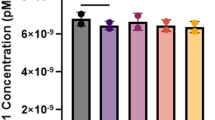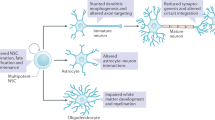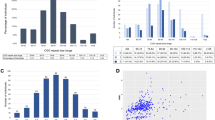Abstract
Fragile X-associated disorders are caused by a CGG trinucleotide repeat expansion in the 5′-untranslated region of the FMR1 gene. Expansion of the CGG trinucleotide repeats to >200 copies (that is, a full mutation) induces methylation of the FMR1 gene, with transcriptional silencing being the eventual outcome. Previous data have shown that FMR1 premutation carriers (individuals with 55–199 repeats) have increased FMR1 mRNA levels with decreased protein (fragile X mental retardation protein (FMRP)) levels. However, the point at which this translational inefficiency occurs, given the increased transcription mechanism, has not yet been explored and remains to be elucidated. We examined the repeat length group, FMR1 transcript and FMRP levels in 74 males with a wide range of repeat lengths using analysis of covariance to better characterize this association. Results showed that the mean FMRP level among carriers with 80–89 repeats was significantly higher than the mean levels among lower (54–79) and higher (90–120) premutation carriers, in spite of the increasing transcript level with repeat length. Taken together, these results suggest that the 80–89-repeat group may lead to different properties that increase the efficiency of translation compared with other premutation repeat size groups.
Similar content being viewed by others
Log in or create a free account to read this content
Gain free access to this article, as well as selected content from this journal and more on nature.com
or
References
Sherman, S., Pletcher, B. & Driscoll, D. Fragile X syndrome: diagnositc and carrier testing. Genet. Med. 7, 584–587 (2005).
Gheldof, N., Tabuchi, T. & Dekker, J. The active FMR1 promoter is associated with a large domain of altered chromatin conformation with embedded local histone modification. Proc. Natl Acad. Sci. USA 103, 12463–12468 (2006).
Tassone, F., Hagerman, R. J., Taylor, A. K., Mills, J. B., Harris, S. W., Gane, L. W. et al. Clinical involvement and protein expression in individuals with the FMR1 premutation. Am. J. Med. Genet. 91, 144–152 (2000).
Kenneson, A., Zhang, F., Hagedorn, C. & Warren, S. Reduced FMRP and increased FMR1 transcript is proportionally associated with CGG repeat number in intermediate-length and premutation carriers. Hum. Mol. Genet. 10, 1449–1454 (2001).
Tassone, F., Hagerman, R., Taylor, A., Gane, L., Godfrey, T. & Hagerman, P. Elevated levels of FMR1 mRNA in carrier males: a new mechanism of involvement in the Fragile-X Syndrome. Am. J. Hum. Genet. 66, 6–15 (2000).
Primerano, B., Tassone, F., Hagerman, R., Hagerman, P., Amaldi, F. & Bagni, C. Reduced FMR1 mRNA translation efficiency in Fragile X patients with premutations. RNA 8, 1482–1488 (2002).
Feng, Y., Zhang, F., Lokey, L. K., Chastain, J. L., Lakkis, L., Eberhart, D. et al. Translational supperssion by trinucleotide repeat expansion at FMR1. Science 268, 731–734 (1995).
Laggerbauer, B., Ostareck, D., Keidel, E. M., Ostareck-Lederer, A. & Fischer, U. Evidence that fragile X mental retardation protein is a negative regulator of translation. Hum. Mol.Genet. 10, 329–338 (2001).
Fu, Y., Kuhl, D., Pizzuti, A., Pieretti, M., Sutcliffe, J. S., Richards, S. et al. Variation of the CGG repeat at the fragile X site results in genetic instability: resolution of the Sherman paradox 1991. Cell 1047–1058.
Allen, E., He, W., Yadav-Shah, M. & Sherman, S. A study of the distribution characteristics of FMR1 transcript levels in 238 individuals. Hum. Genet. 114, 439–447 (2004).
Meadows, K., Pettay, D., Newman, J., Hersey, J., Ashley, A., Sherman, S. Survey of the fragile X syndrome and the fragile X E syndrome in a special needs population. Am. J. Med. Genet. 64, 428–433 (1996).
Crawford, D., Meadows, K., Newman, J. L., Taft, L. F., Pettay, D. L., Gold, L. B. et al. Prevalence and phenotype consquence of FRAXA and FRAXE alleles in a large, ethnically diverse, special education-needs population. Am. J. Hum. Genet. 64, 495–507 (1999).
Tassone, F., Beilina, A., Carosi, C., Albertosi, S., Bagni, C. & Li, L. et al. Elevated FMR1 mRNA in premutation carriers is due to increased transcription. RNA 13, 555–562 (2007).
Gracia-Alegria, E., Ibanez, B., Minguez, M., Poch, M., Valiente, A. & Sanz-Parra, A. et al. Analysis of FMR1 gene expression in female premutation carriers using robust segmented linear regression models. RNA 13, 756–762 (2007).
Zumwalt, M., Ludwig, A., Hagerman, P. & Dieckmann, T. Secondary structure and dynamics of the r(CGG) repeat in the mRNA of the fragile X mental retardation 1 (FMR1) gene. RNA. Biol. 4, 93–100 (2007).
Beilina, A., Tassone, F., Schwartz, P. H., Sahota, P. & Hagerman, P. J. Redistribution of transcription start sites within the FMR1 promoter region with expansion of the downstream CGG-repeat element. Hum. Mol. Genet. 13, 543–549 (2004).
Singh, K. & Prasad, S. Differential expression of Fmr-1 mRNA and FMRP in female mice brain during aging. Mol. Biol. Rep. 35, 677–684 (2008).
Entezam, A. & Usdin, K. ATR protects the genome against CGG CGG-repeat expansion in Fragile X premutation mice. Nucleic. Acids. Res. 36, 1050–1056 (2008).
Handa, V., Goldwater, D., Stiles, D., Cam, M., Poy, G., Kumari, D. et al. Long CCG-repeat tracts are toxic to human cells: implications for carriers of Fragile X premutation alleles. FEBS Lett. 579, 2702–2708 (2005).
Iwahashi, C., Tassone, F., Hagerman, R. J., Yasui, D., Parrott, G., Nguyen, D. et al. A quantitative ELISA assay for the fragile X mental retardation 1 protein. J. Mol. Diagn. 11, 281–289 (2009).
Acknowledgements
We thank Dr Stephen Warren for kindly providing the anti-FMRP (J1) antibody. This work was supported by the National Institutes of Health grants R01HD029909 and G12GM00680.
Author information
Authors and Affiliations
Corresponding author
Rights and permissions
About this article
Cite this article
Peprah, E., He, W., Allen, E. et al. Examination of FMR1 transcript and protein levels among 74 premutation carriers. J Hum Genet 55, 66–68 (2010). https://doi.org/10.1038/jhg.2009.121
Received:
Revised:
Accepted:
Published:
Issue date:
DOI: https://doi.org/10.1038/jhg.2009.121
Keywords
This article is cited by
-
Spectrum of Syndromal Disorders Associated with Expansion of CGG Repeats of the FMR1 Gene Promoter: Pathogenetic Mechanisms and Clinical Manifestations
Neuroscience and Behavioral Physiology (2023)
-
AGG interruptions and maternal age affect FMR1 CGG repeat allele stability during transmission
Journal of Neurodevelopmental Disorders (2014)
-
Use of model systems to understand the etiology of fragile X-associated primary ovarian insufficiency (FXPOI)
Journal of Neurodevelopmental Disorders (2014)
-
Genomic studies in fragile X premutation carriers
Journal of Neurodevelopmental Disorders (2014)
-
Intranuclear inclusions in a fragile X mosaic male
Translational Neurodegeneration (2013)



